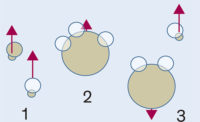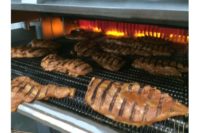Improving Processing Processes Through Remote Video Auditing
Consumers and regulatory agencies demand that processors operate their facilities under the strictest of guidelines. Quality assurance (QA) personnel are given a tremendous responsibility, ensuring that Hazard Analysis & Critical Control Point (HACCP) plans are enforced and possible contamination areas are monitored often. But who monitors the QA personnel? Who assures that they are monitoring critical control points effectively?
ADT and its partner, Arrowsight, have introduced a new service, remote video auditing (RVA), which utilizes existing in-plant video hardware to monitor and audit QA operational performance. RVA addresses major food production issues of today, including traceability, food quality, security, and efficiency.
Program components
The battery of the ADT/Arrowsight RVA program consists of the cameras and recording devices in the plant and the off-site, third-party auditors who analyze the data.
At the plant, RVA software is integrated with the plant’s existing hardware like digital video recorders (DVR) and data sources, including security systems and food processing temperature gauges. Images and records are remotely retrieved by an off-site team, and video auditors then examine a combination of still pictures and motion video taken at the plant during the day. These auditors prepare weekly e-mail “score cards” that summarize an individual location’s performance on a “Rating 1/ Rating 2” basis. In addition to audit reports, Web-based hyperlinks to each and every video event reviewed are offered providing visual documentation of the events uncovered by the auditing service. Processors are able to access and review the actual recorded video and still images through links that are provided with the e-mailed reports.
With this technology, processors can regulate how often and how thoroughly QA personnel perform quality checks as well as inquiries including, “Was an area cleaned and were food safety regulations followed?” RVA can also analyze operational performance at critical control points, including blending and cooking procedures, injection and tumbling areas, chilling and heating processes, and raw materials receiving.
“RVA offers a return on investment [ROI] that is immediate and entirely quantifiable,” explains Adam Aronson, Arrowsight’s chief executive officer. “At a processing facility, we can put cameras on the grinding and blending areas because it’s very important to make sure that the meat-blending process is conducted in a specific order because if it’s not — you might have to throw out a ten-thounsand pound batch of meat that costs one dollar a pound.
“When you are running a fifty-million dollar to one-hundred million dollar meat-processing plant, that sort of recurring waste is devastating,” he adds. “If that happens once or twice a week, those numbers add up to millions and millions of dollars in lost goods. A processing plant that sells one-hundred million dollars of meat a year, for example, might invest about two-hundred fifty-thousand dollars per year for this service, which is less than a quarter of a penny for every pound of meat sold. The return on investment would begin to accrue immediately after installation.”
History of excellence in auditing
While ADT/Arrowsight is new to the processing industry, its RVA technology has been in use for more than six years. Six years ago, Arrowsight was originally a company called ParentWatch, which put cameras and video servers into childcare centers that typically cared for more than 100 children. In 2000, Arrowsight expanded the businesses beyond childcare into other commercial marketplaces.
“In 2000 we looked to see how the technology could benefit other industries,” Aronson explains. “Taking an ‘outside-in’ approach to refine the company’s offerings, we logged hundreds of hours in the field monitoring convenience stores, quick-serve restaurants, retail stores, and food and meat processing plants in order to identify the common denominators of business — their drivers and challenges. Our diligence resulted in taking the technology one step further to develop RVA services.”
The Plumrose partnership
One of the first processors to get on-board with ADT’s RVA program is East Brunswick, NJ-based Plumrose USA. Plumrose, which was founded in the 1930s, provides retail and foodservice accounts with premium sliced meats, deli meats, and bacon.
One of Plumrose’s largest facilities is its Council Bluffs, IA, plant where they produce about 3-million pounds of product a week. Plumrose implemented RVA at this facility. Mike Rozzano, Plumrose’s general manager, relays that RVA was implemented because in order for a company to maximize its food-safety program, there has to be a way to audit the people who are doing quality-control checks.
“Our motivation for starting a RVA program is pretty simple,” Rozzano explains. “Under HACCP, you say what you will do, you do it, and then you document it. We have QA people who are checking our critical control points. With RVA, we now have someone checking the checker.
“Simple video is not enough,” he adds. “You can’t watch all the video. A continuous third-party audit is more comprehensive and objective than anything we’d be able to do on our own.”
Plumrose uses RVA to monitor its pickle making, injection, stuffing, cooking, and demolding operations. RVA is also used within the plant to monitor certain quality control functions including record keeping and shipping. Currently, Plumrose is using 26 different cameras for this operation.
Rozzano said Plumrose uses its RVA program to improve internal performance and as a marketing device.
“When we get poor audit reports, we will be able to make improvements to the specific areas necessary,” he says. “When we get good audit reports, we will be able to use those both to improve corporate moral and also as a marketing tool. We will be able to point to an objective report saying we are exceeding our food-safety goals.”
Plumrose’s implemented ADT/Arrowsight’s RVA program in September and early indications say the program is a success. Rozzano says, “Ideally, Plumrose will extend RVA to the rest of the Council Bluffs facility and then roll the program out to its facilities in Booneville, MS, and Elkhart, IN.
HACCP was revolutionary as it vastly improved how plants monitor its food-safety procedures. However, HACCP puts a lot of pressure and responsibility on the hands of QA personnel. ADT and Arrowsight have moved food safety forward by giving plants the ability to objectively and continuously monitor the job QA does.” NP
ADT, phone (877) 258-6424, or visit www.adtselectvision.com
Arrowsight, phone (866) 261-5656, or visit www.arrowsight.com
Getting started — the hardware
Processors can use their existing video-monitoring equipment investment with ADT’s service. There are two main components of a video system, the camera and the recording device that records the video and then acts as a remote server for the cameras. Today, cameras record to DVRs. There are two leading DVR manufacturers, Tyco and General Electric. Arrowsight’s software is compatible with both types of DVRs.
ADT’s service can utilize any existing cameras that are already in place at processing facilities. Compatible cameras include everything from simple old black and white analog cameras, to color analog cameras, to digital cameras. Future improvements to the RVA service include making its system compatible with more DVR systems.
“In a lot of cases, the larger corporate customers that have been buying DVRs over the last couple of years have been buying DVRs made by GE or Tyco,” explains Adam Aronson, Arrowsight’s chief executive officer. “And so we are immediately compatible. Over time, we will be making an effort to be compatible with all the top selling brands of DVRs.”
ADT, phone (877) 258-6424, or visit www.adtselectvision.com
Arrowsight, phone (866) 261-5656, or visit www.arrowsight.com







